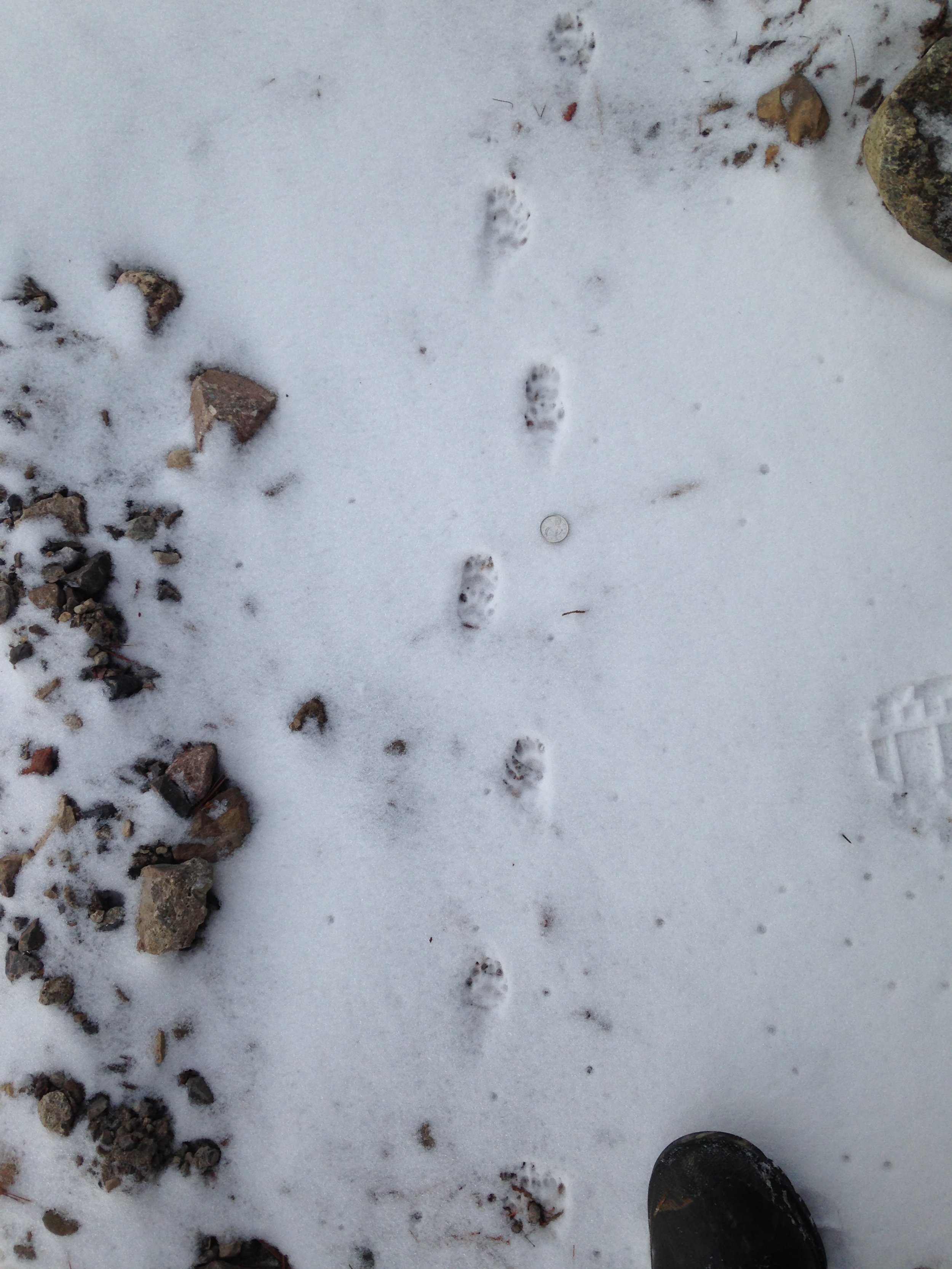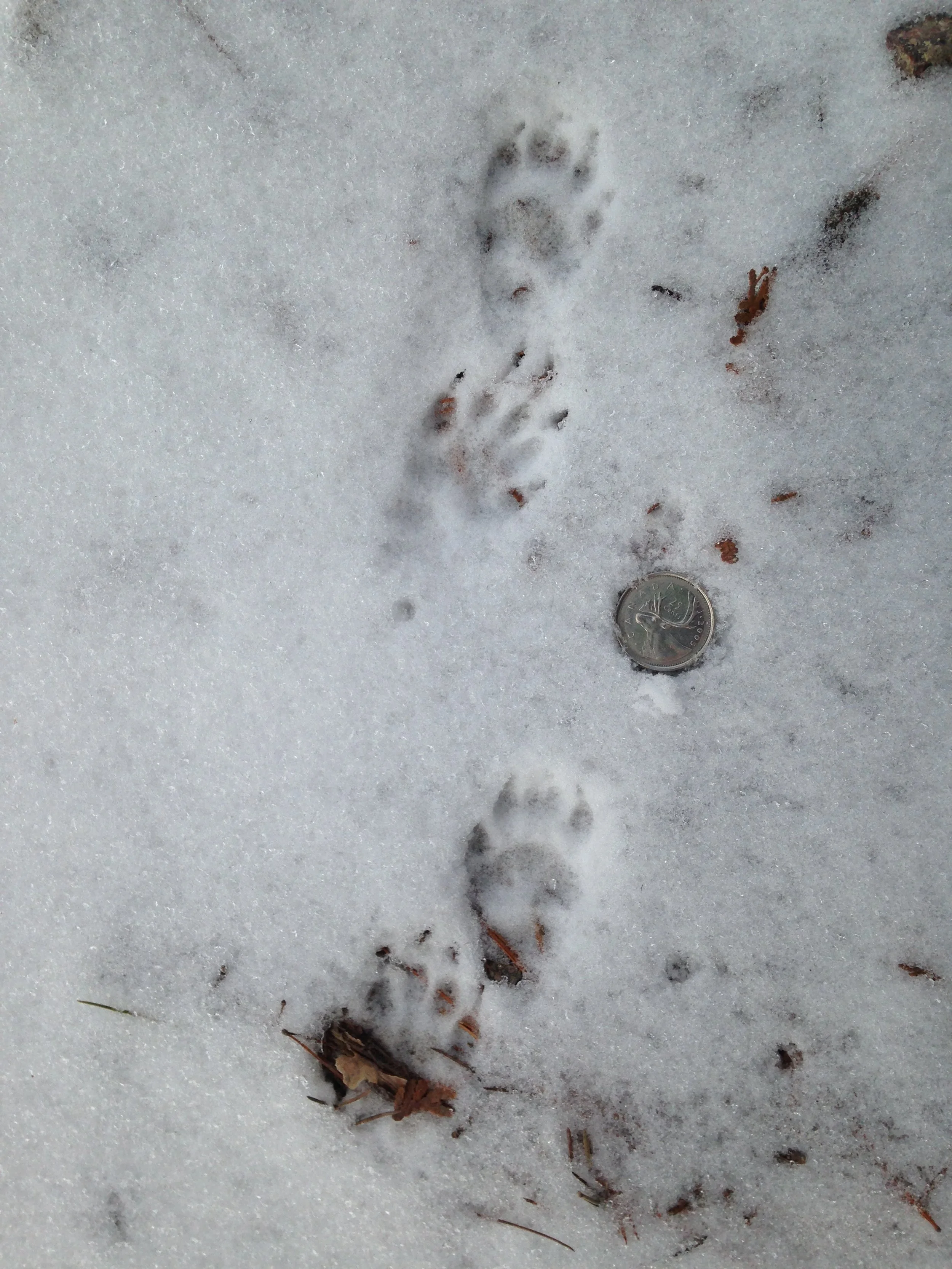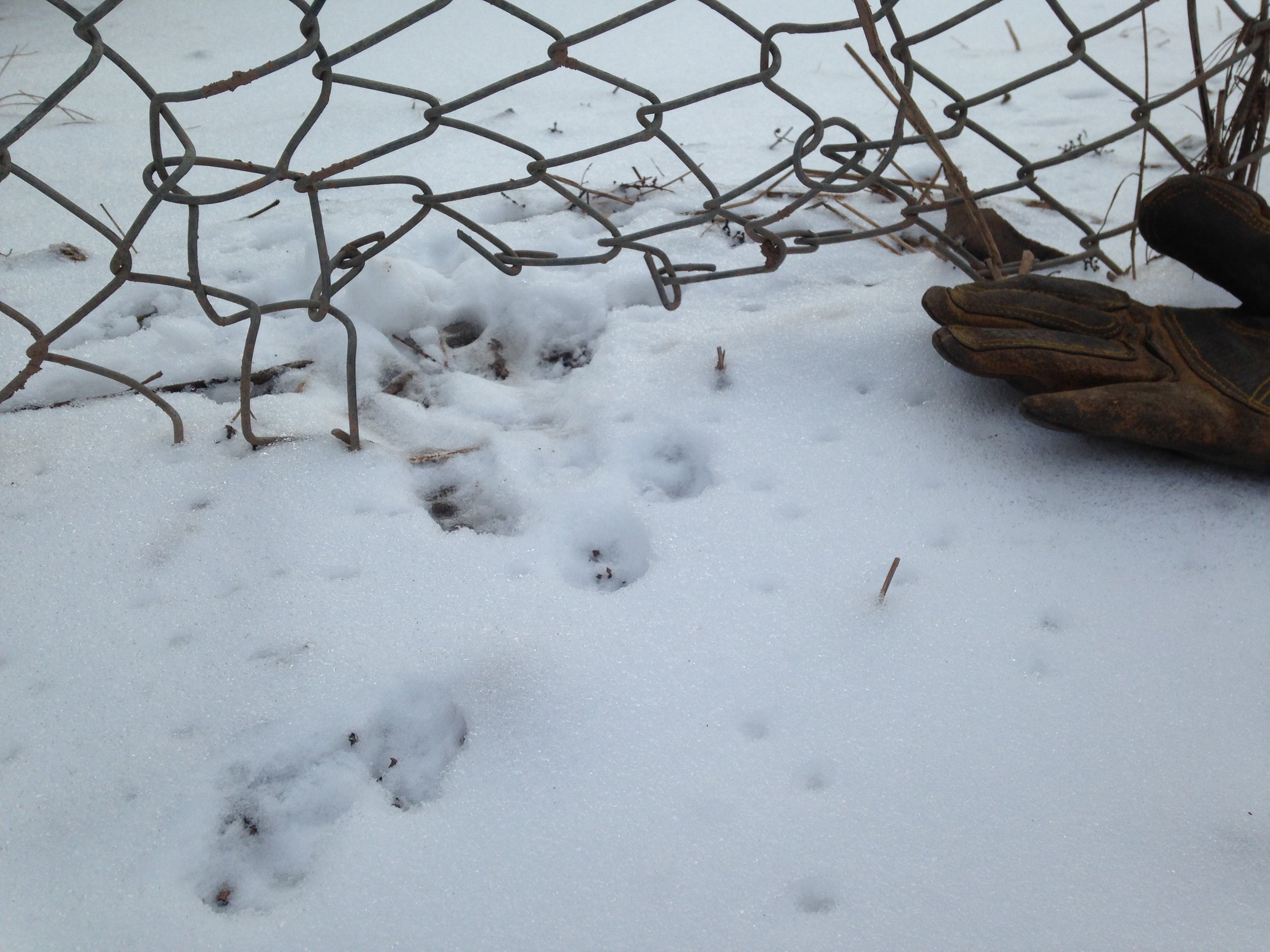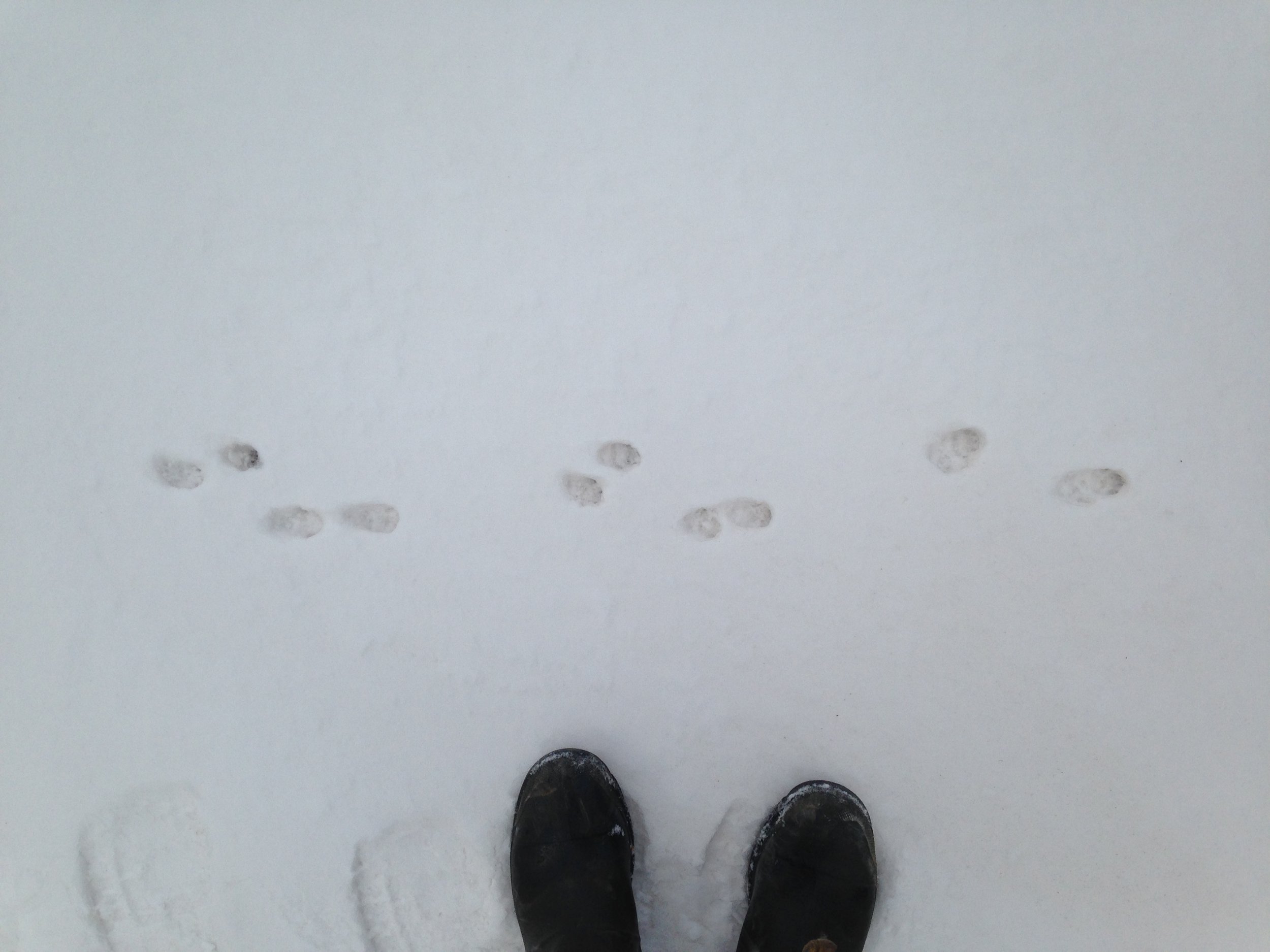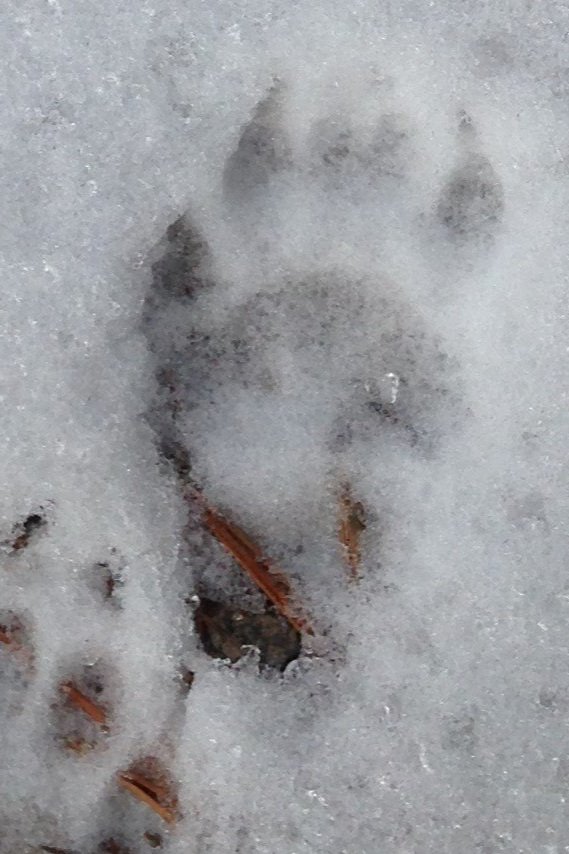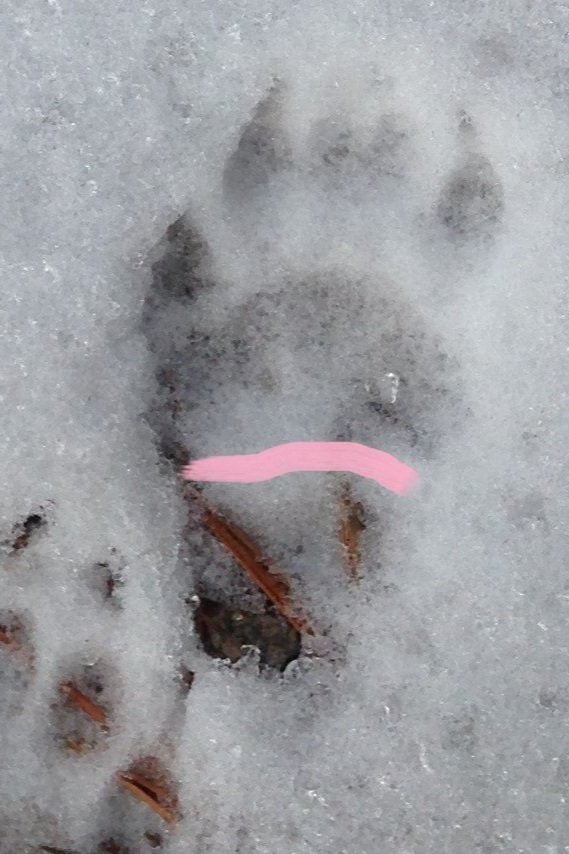Tracking Journal, 2021.12.28
It was really windy at the top of the hill. I was really grateful that I had the forsight to bring my jacket, even if I had that thought that it was supposed to warm up a little over the day. For now it was early, it was windy and I was cold. Opening with my backpack to pull out my coat while trying to not ruin the White-footed Deer Mouse (Peromyscus spp.) trail in front of me was a challenge, but once the coat was on, my attention was on the trail. I have been trying to pay more attention to the different trails of small mammals recently and these Mouse trails were really fun to check out. They emerged from small tunnels below some of the larger rocks atop the gravel hill I had just climbed. Along they bounded and made their way through the old desiccated stalks of Wild Carrot (Daucus carota), Evening Primrose (Oenothera biennis), and some sort of Goldenrod (Solidago sp.) only to end up in another hole beneath some similar rocks. There were quite a few trails around so I assumed that there were many Mice meandering between the plants. Perhaps those dried up plants were still dropping seeds once in a while, or perhaps the Mice had stored some away in a cache site under a rock? How much seed does a Mouse need to last until Spring? I read recently in Stokes Guide to Animal Tracking and Behaviour that Mice are generally pretty solitary unless it is around mating season, or during the cold months of Winter when “several to many adults may huddle together in the same nest to withstand the cold.” I have also read that the Mice will cache in multiple locations, under logs, hollow logs, stumps, birds nests, rocks, any nooks or crannies where they can access, they will store food throughout the Autumn and then come back in the Winter. Mice will also usually navigate under the snow layer in the subnivean zone (under the snow) where the temperature of the earth has melted a space where many creatures spend the Winter months. But this only works if the snow sticks around and more snow falls on top creating that insulative layer. This Winter so far, the snow falls, sticks around for a day or two, and then melts. I bet this is leading to some hardship for a lot of the smaller animals who inhabit that space. We’ll have be on the look out for Mice predator populations in the future to see if there is any decline, cause if their prey is missing, the predators will likely not have as many young in the coming years.
Just beyond the Mice trails there was a small crest of gravel and stone and I wanted to check out the other side of to see how high up I was on this rubble hill compared to the ground below. As I checked out the other side I noticed a trail from a larger mammal moving pretty fluidly along the steep hilltop.
Red circles are where the Fox tracks were as they made their way over and through the boulders.
The trail was definitely Canid, but who? I have been mixing up Red Foxes (Vulpes vulpes) and Eastern Coyotes (Canis latrans) a bit when out tracking so I wanted to take a closer look, to examine with a bit more intention. There are clues to help differentiate between the two beyond just assumed size.
Mark Elbroch in the book Mammal Tracks and Sign describes Red Fox toes in tracks appearing as pointed and a little more angular then the rounded toes often found in other Canid tracks. Another sign to look for is the fur in the tracks because the Red Foxes have more fur growing on their feet then Coyotes do. Additionally, the heel pad on the front feet (the metacarpal pad) sometimes appears as a flat line or a chevron or boomarang, an obtuse inverted V shape and the bulbous heel pad on the hind feet (the metatarsal) often appears like a small thumb print in the tracks. Then there is also the overall size to consider (Fox tracks will most often be smaller), and the location (Foxes will more likely be found in residential neighbourhoods). I have discovered Coyote tracks on this same hill before but I think I had to conclude this time that it was a Fox. I looked at the trail along the top of the ridge line and could just imagine the smaller Fox nimbly making their way along that narrow path. It seemed even more conclusive when a few minutes later I came across more of the Fox trail, but this time the trail was at the bottom of the hill going up, between and over some big boulders. This too was fun to image the animal jumping around, leaping from rock to rock. To get a few photos I even got up on top of some of the boulders and began trying to move around as I imagined the Fox was. Another reminder that I am not a Fox and definitely not as nimble.
I followed the Fox trail up the hill again, but when they went down the far side of the hill once more, heading back in the direction where I had come from, I turned and headed in the direction of the Cedar (Thuja occidentalis) forest I was aiming to explore little. I didn’t make it far when I got to a road and found myself crossing another animal’s trail.
I come across this animal’s trail a lot. But it is always fun to find as there is variation and uniqueness to every trail I find. Nothing too big, but I bet a more skilled tracker could identify individuals from the particularities in the trails. I looked at the trail in front of me and then backtracked (headed in the direction where the animal was coming from) along the access road I was crossing and what was a sort of direct register walk at my feet was more of an over step walk (a slower gait) further back on the trail, which turned was a lope even further back and then a walk again just as they emerged from under a fence. This trail was all over the map, and would have been fun to watch the animal make the trail and then review the tracks afterwards. I’ll have to set up a trail cam someday.
To identify the species I look at the feet and I look to see how many toes there are. One all the feet I see 5 toes, unless debris got in the way of a toe registering. So, 5 toes on fronts and hinds. Not a Rodent, or anything in the Dog (Canidae) or Cat (Felidae) family. Could be a Weasel (Mustelidae), Raccoon (Procyonidae), Skunk (Mephitidae), while the family has 5 toes on each foot, my location and the size of the tracks would eliminate Bears (Ursidae). So, Weasels, Raccoons and Skunks. At one point in history all three of these families were considered the same family, but distinction in the form of the skulls led to considering them different families. Let’s eliminate some.
Weasels gaits are a little more consistent then what I was seeing here and don’t usually move with an overstep walk. They prefer a 2x2 lope to cover open areas like where this animal was. Also most Weasels that would be found in the type of environment I was in, along a road behind a gravel hill, away from water, would have had tracks that were much smaller than this animal. So, not a Weasel.
Raccoons (Procyon lotor) would totally be in this area and I have found some of their trails before around that spot. They also have five toes which generally point forwards like this animal but the metatarsal pad doesn’t register the same way as this animal does. The Raccoon metatarsal pads have fused throughout their evolution to create a singular pad in their tracks where as this animal’s heel pad on the hind feet has a bit of a horizontal crease across the middle of the track Another feature of the trail which didn’t match a Raccoon is that while Raccoons have claws on their front and rears which can be sort of big, they do not match this animal’s claws on the front feet which extend far beyond the toes, claws that have evolved for digging up small grubs and insects. So not a Raccoon.
Who does this leave? A Striped Skunk (Mephitis mephitis). Skunks have all the characteristics described above. They are really common and even though the Skunks will sort of den up in the Winter months, it hasn’t been too cold around here to really motivate the Skunks to bunk up in their dens. We’ll have to see in the coming months whether the Skunks head to dens or not.
As I left the Skunk trail at the fence I walked only a couple of feet when there was another Fox trail. It very likely was the same Fox as before just making the rounds. I followed the Fox as they hugged the fence line the Skunk had crawled under and watched as they trotted directly over a small tuft of grass. Whenever I see behaviour like this I get down on my knees and start sniffing the grass. Quite a few animals, but especially Foxes it seems love to scent novel elevations along their routes. This tuft of grass was perfect for them. I got down and started sniffing. Fox urine is a fairly potent cocktail of water, urea, creatinine and excess minerals, with some researchers looking at compounds only found in Fox urine, such as sulfur compounds 3-isopentenyl thiol, 1- and 2-phenylethyl methyl sulfide, octanethiol and benzyl methyl sulfide. Who even knows what those are? I mean someone does, but I don’t. Some researchers believe these chemicals lead to highly evolved communication capabilities between individual Foxes, and their prey. Red Fox urine known to their potential prey species that folks bottle it and sell it in stores! But I have also interviewed a wildlife biologist, Jeremy Pustilnik, who did a project trying to observe the effects of mounting Fox urine in and around old Groundhog (Marmota monax) burrows which were being used by different animals for shelters against the cold. He noted in his paper “The effects of red fox scent on winter activity patterns of suburban wildlife: evaluating predator-prey interactions and the importance of groundhog burrows in promoting biodiversity” that most of the animals which came to the burrowing sites didn’t seem to mind the threat of a possible Fox vs the more tangible, immediate threat of the cold. Animals of all sorts took up refuge in the Groundhog burrows, including an American Robin (Turdus migratorius). But I can only explain so much of what they found here. There is a lot more they found out from the research. If you have the time, check out the episode.
I got up from the tuft of grass and kept on following the Fox trail. It was fun to follow because it was interesting to note what sorts of things were catching the Fox’s attention. The tuft of grass, the fence line, even a lower hill which had been created at the edge of the property. The Fox made their way to the top of this hill which overlooked a meadow, stopped there, likely to sniff the air and see who was about, and then made their way back down the same side they had come up. I practice smelling the air there as well, but I couldn’t smell anything too unusual, just the smell of the warmer Winter morning.
Following the Fox trail again, I kept on as they rounded a backhoe on the property and made their way around a Scots Pine (Pinus sylvestis) and into the field. I stood confused for a second when I got past the Pine tree. In the snow in front of me were multiple sets of tracks, not just the Fox. I looked more carefully and sorted out who’se tracks I was seeing. The first ones I picked out were easy, with their three long narrow toes in the front, a bulbous metatarsal, and another toe pointing the other direction… it could only be a bird. There was more than one of them. A big flock, or a “rafter”. It was large, and in an open field beside a Cedar forest my friends and I loving refer to as “Turkey Woods”. Of course, it was Wild Turkey (Meleagris gallopavo) tracks. The other animal in the mess of tracks was another Canid, but larger, and more pronounced than the Fox. A heavier animal must have had made it. A Coyote was following the Turkey trail through the meadow, past the small grove of Black Locust (Robinia pseudoacacia) trees which, according to one book I found on Turkey biology and management, the Turkeys will sometimes consume the seeds from the fallen pods.
I followed the Coyote for quite a while, maybe a half hour as they made their way threading themselves through the browned Goldenrod stalks and other forbs in the meadow. I could feel the brain fog settling in which I get sometimes after serious focus for a while. I ended up losing the trail back against the edge of the property where the meadow and the gravel hills met. My brain was just unfocused and I was honestly getting a little bored of following this animal around. At the base of a tall Maple (Acer sp.) I stopped looking down for a second and took a drink and ate something instead.
I decided to not search for the Coyote trail but make my way towards the Cedar forest as I had planned. I stopped to investigate a Scots Pine (Pinus sylvestis) branch which had fallen from an unknown source. The branch had landed atop a small Cedar tree about a meter off of the ground. The Pine needles and the branch itself appeared to have been chewed on, and the chews were all at a 45°. This led me to wonder about possible Rodents like Porcupine (Erethizon dorsatum) or a Lagomorph like an Eastern Cottontail Rabbit (Sylvilagus floridanus). There were Rabbit tracks on the ground around the base of the Cedar tree that the branch had landed on, but I couldn’t tell how old the branch was. I wonder now if a Porcupine had cut, browsed, and then dropped the Pine branch from higher up, as it was too high for a Rabbit to have access to. During colder Winters when the snow sticks around and gets high, then a Rabbit could certainly be browsing a plant that is located higher up but since the Winter around here has been so warm, the snow hasn’t gotten deep enough to really offer access for a Rabbit.
I looked down from the Pine branch once more and noticed some Canine tracks beside the Rabbit. Looks like another Fox had made their way through here, but I didn’t have it in me to continue on one trail anymore and I just slid under the cover of a thick copse of young thin Cedar poles until I came out into an older, wetter, darker Cedar forest. I have explored this forest a lot. I have come here many times and trailed Deer (Odocoileus virginianus), Porcupines, Coyotes, Foxes, and Turkeys. It is a lovely place. I was keeping my eyes to the ground for trails of animals I had not followed yet that day, and also looking up occasionally in hopes that I could spot a Turkey or two perched in the trees. I spooked a Ruffed Grouse (Bonasa umbellus), but for the first time in quite a while I didn’t jump when they clattered off. A Turkey also got spooked a little later and I watched them make a short flight and slow descent into the jumble of fallen trees in the wetter part of the woods. I decided not to follow so as to not put any undue pressure on the bird. I was perceiving my slowness and, dare I say, my boredom? It is nice to visit the same places over again to see what has changed and who is moving through, but I was feeling the tether of home and the urge to explore was lessened. I guess every tracking adventure can’t be an 8 hour day, and sometimes you just have to head home early.
I was still grateful for the time spent out, for the gift of mystery and wonder that the tracks had inspired. I am really stoked on those Mice, the Fox, the Skunk for getting me hooked right away. I do know I will be back there, and likely soon.
To learn more :
Chemical Scent Constituents in the Urine of the Red Fox (Vulpes vulpes L.) During the Winter Season
Volatile scent chemicals in the urine of the red fox, Vulpes vulpes
Ep. 147 : Fox and Rabbit predator-prey interactions with wildlife behavioral ecologists Jeremy Pustilnik and Paul Curtis
The effects of red fox scent on winter activity patterns of suburban wildlife




